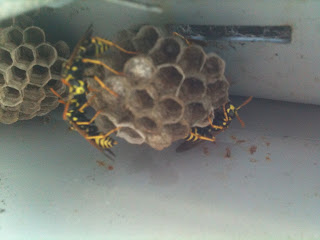 |
| A tiny colony - right, and last year's abandoned cells to right |
The only wasps that have ever given us trouble are the yellow jackets. I was once stung by them, when I accidentally mowed their colony's exit site.
That wasn't really their fault, but we have other problems with them. We trap and destroy them to protect the bees.
The greenhouse wasps are a different species, some kind of Polistes or paper wasp.
 |
| The greenhouse - favorite building spot |
Paper wasps look similar to yellow jackets, but with longer, reddish antenna and narrower bodies. They build open celled paper nests on sheltered spots a few meters above the ground. They build new nests each year, but they strongly favor certain sites and like to rebuild there. In the nest below, they built new cells right next to an abandoned nest built by a different colony last year. They simply will not reuse!
 |
| Closer view of the colony. |
The colony pictured was one of several built in the west eves of the greenhouse. For reasons of their own, the wasps usually build in the west side of structures. This picture was taken on a cold, rainy day, when few insects were flying. I'm guessing the wasps shown represent 75% of the whole population. A tiny colony, where every worker matters. No wonder they are reluctant to take risks, like flying out to sting me. Not complaining, mind you.
On sunny days, the wasps wander around inside the greenhouse or fly out through the vents to gather their favorite food - caterpillars and other insects. These wasps are part of our pest management system.
 |
| Achocas (green) were pollinated by wasps last season |

Paper wasps have small colonies compared to yellow jackets, honey bees or bumble bees. On sunny days, there may be just a handful of insects at the nest, with everyone else out hunting. I have not spent enough time with the colony to know for sure whether the same couple of wasps is always at home, or whether they take turns. I guess the next step would be to color mark them and see. I'm still a little too shy to try that.

Being a queen wasp is a little more flexible than being a queen bee. In the fall, the wasps born near the end of the season are big, plump, and exceptionally well fed. The females of this group mate, and then go into sheltered spots to hibernate till spring. They found, populate and provision colonies in spring, and thus each one could be a queen. But in reality, several often share the same nest, and even take turns hunting and laying eggs until one gradually pushes the others out of the role of queen. Or if one has more viable eggs, her daughters may help her suppress the others.
I have stood under colonies, sometimes for half an hour or longer, and never been bothered by the wasps. I've stood right next to them while they gathered wood, chewing splinters off our fence and stashing them in their gullets. They take the wood home, chew it up, and turn it into paper. If I offered them colorful material, they might make pinatas. I haven't experimented with that.
I've watched one lay eggs - a sweet, domestic sight. When I was taking pictures, I was a typical noise, clumsy, human, and jarred the nest a couple of times. The wasps did come out and menace me. One even flew a few centimeters, landed on an eve, and crouched in a threatening manner, but didn't approach or try to sting.. I haven't pushed my luck further than that. I know that bees hives seem to retain memories of individual people for weeks or months, and I don't want to find out that wasps do too. At least, not bad memories.
No comments:
Post a Comment